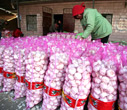China
More headed to HK for flu jabs
By Chen Hong (China Daily)
Updated: 2009-11-26 08:18
SHENZHEN: The worsening H1N1 flu situation is prompting some local residents to pay for vaccines in the neighboring city of Hong Kong when they become available next month.
So far, Shenzhen's free H1N1 flu vaccine program, which was launched at the end of last month, only covers medical staff and frontline workers in the fields of quarantine, immigration, customs, public security and transportation, as well as teachers and students.
Everyone else might be able to benefit from the free program by next April, but that is heavily dependent on the supply of the vaccine, government sources have said.
Zhong Ming, a 35-year-old bank clerk, said he plans to get vaccinated in Hong Kong with his wife as long as the price is acceptable.
"The idea of getting vaccinated became more urgent when one of my colleagues was infected last week," Zhong said.
The health authority of the Hong Kong Special Administrative Region said two weeks ago that it placed orders for 3 million doses of H1N1 flu vaccines from France and the first batch of 500,000 would arrive in December.
While the government would provide free vaccination to five categories of high-risk groups, including medical staff, children, senior citizens, pregnant women and livestock and slaughterhouse workers, it would also supply vaccines to private doctors at cost so others can get the vaccines.
Xie Ruosi, a senior official with the Shenzhen health authority, also advised local residents to wait for the free vaccines.
"The country will allocate more vaccines to Shenzhen. There's no need to get them in Hong Kong," he said.
However, some residents still remain cautious about the effect of vaccines given that two people died after being vaccinated.
"We don't plan to take the vaccine even if it's free," said Ye Xue, a 33-year-old office worker and mother of a 4-year-old boy.
"We believe it's better to pay more attention to personal hygiene and stay away from crowds," she said.
The local disease control center said all flu samples in Shenzhen have had the H1N1 virus in the past two weeks, up from 70 percent to 80 percent before.












